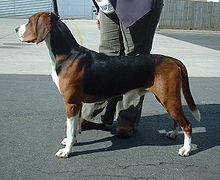| Hamiltonstövare | |||||||||||||||||||
|---|---|---|---|---|---|---|---|---|---|---|---|---|---|---|---|---|---|---|---|
 Male Hamiltonstövare | |||||||||||||||||||
| Other names | Hamilton Hound, Swedish Foxhound | ||||||||||||||||||
| Common nicknames | Hamilton | ||||||||||||||||||
| Origin | Sweden | ||||||||||||||||||
| |||||||||||||||||||
| |||||||||||||||||||
| Dog (domestic dog) | |||||||||||||||||||
The Hamiltonstövare or Hamilton Hound is a breed of scenthound originally developed by the founder of the Swedish Kennel Club, Count Adolf Hamilton. Its ancestors include several German hounds as well as English Foxhounds and Harriers. The breed is recognized by the Swedish Kennel Club, Federation Cynologique Internationale (FCI) and the American Kennel Club's Foundational Stock Service.
Appearance
editCharacteristics
editThe Hamiltonstövare is a medium-sized dog with a well-balanced and muscular frame. It has a short, and dense coat and tri-colored, typically featuring a combination of black, tan, and white markings. The breed's distinctive appearance, coupled with its elegant gait, reflects both its functional capabilities and aesthetic appeal.[1][2] Male dogs should be between 53–61 centimetres (21–24 in) and females between 49–57 centimetres (19–22 in) tall.[1] Generally they weigh between 23–27 kilograms (51–60 lb).[3]
Temperament
editKnown for its keen sense of smell and hunting skills, the Hamiltonstövare is bred for hunting hare and fox,[4] especially in tracking scents alone[5] over the varied Swedish terrains, including dense forests, open fields, or rugged mountains.[citation needed] The Hamiltonstövare's acute sense of smell allows it to excel in most hunting tasks; however, they have been bred to refuse to track deer.[6]
The Hamiltonstövare is friendly and has a sociable nature. While it possesses a strong hunting instinct, it is also a loyal and affectionate companion. The breed tends to form strong bonds with its family members and is generally good with children. However, the breed can be stubborn and early socialization and training are crucial to ensure that the dog's hunting instincts are appropriately channeled.[6][7]
History
editThe use of scenthounds in Sweden dates back at least to the 1500s when it is thought that Eastern European hounds were brought to Scandinavia. There is some disagreement as to the ancestors of the Hamiltonstövare, and various authorities have proposed native Swedish hounds, Swiss and German hounds such as the Holstein hound or the Hanover hound, Latvia's now extinct Curland hound, the English foxhound and harrier.[5][3] In the late 19th century, Count Adolf Patrick Hamilton, a Swedish cavalry officer and the Swedish Kennel Club's first president, dedicated his efforts to developing a breed that would excel in hunting and tracking and at an 1886 dog show, he presented two dogs which would be considered the first Hamiltonstövare.[1][5][8] The result was a dog with a robust build, well-suited for navigating the diverse terrains of the Swedish countryside.[3][9] While a popular hound in Sweden, the breed is rare outside of Scandinavia.[3] Originally simply called the Swedish hound, like the Schillerstövare and the Hygen hund, the breed was later renamed Hamiltonstövare after its creator in 1921 when it was recognized by the Swedish Kennel Club in 1921.[8][1] The Federation Cynologique Internationale (FCI) recognized the Hamiltonstövare in 1955, and the breed is currently part of the American Kennel Club's Foundational Stock Service.[1][10][11]
Popular Culture
editAccording to Swedish folklore, the elf Tomten is assisted by a Hamiltonstövare named Karo.[3]
References
edit- ^ a b c d e "Hamiltonstövare" (PDF). FEDERATION CYNOLOGIQUE INTERNATIONALE. 2017-02-10. Retrieved 2024-01-15.
- ^ Mason, Walter Esplin (1915). Dogs of All Nations. Panama-Pacific International Exposition. p. 92.
- ^ a b c d e Wilcox, Bonnie; Walkowicz, Chris (1993). Atlas of dog breeds of the world. Neptune City, NJ: TFH Publications. p. 487. ISBN 978-0-86622-551-9.
- ^ Jansson, Mija; Laikre, Linda (2018-09-12). "Pedigree data indicate rapid inbreeding and loss of genetic diversity within populations of native, traditional dog breeds of conservation concern". Plos One. 13 (9). Public Library of Science: 4 – via Internet Archive.
- ^ a b c Morris, Desmond (2002). Dogs: The Ultimate Dictionary of over 1,000 Breeds (Reprint ed.). Trafalgar Square Pub. pp. 102–103, 107. ISBN 978-1-57076-219-2.
- ^ a b "About Hamiltonstovare". Hamiltonstovare Club of America. Retrieved 2024-01-16.
- ^ Morris, Seren (2021-02-28). "The 24 Least Obedient Mid-Size Dog Breeds". Newsweek. Retrieved 2024-01-16.
- ^ a b Hörter, Ria (2013). "Count Adolf Patrik Hamilton and the Hamiltonstövare". Masterminds (PDF). Dogs Magazine. pp. 218–224.
- ^ "Hamiltonstövare Facts - Wisdom Panel™ Dog Breeds". Wisdom Panel™. Retrieved 2024-01-16.
- ^ "Hamiltonstovare - Dog Breed Information". American Kennel Club. Retrieved 2024-01-16.
- ^ "HAMILTONSTÖVARE". www.fci.be. Retrieved 2024-01-16.
See also
edit
Category:Dog breeds originating in Sweden
Category:FCI breeds
Category:Rare dog breeds
Category:Scent hounds